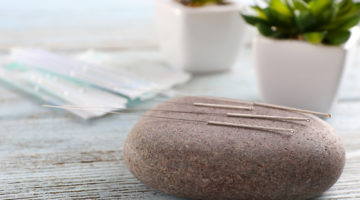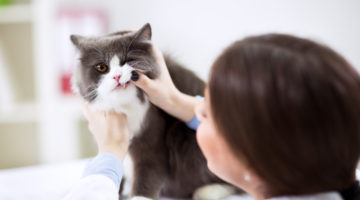We’ve all heard the saying that a cat has nine lives. If you want your feline friend to enjoy his in peak condition, you need to do everything you can to prevent disease and treat any illness that does arise.
In this article, I’ll share the nine steps I take with my own feline clients to help them live long and healthy lives.
1The good food movement
The very first step is to feed your cat the best, most natural diet you can. This is so important that it’s top of the list in my program.
The goal is to reduce the amount of bad stuff you put into your cat, and increase the good stuff. To do that, you need to learn to read the labels on your cat’s food. Avoid products with animal or plant by-products, artificial preservatives and flavorings, and chemicals like BHA, BHT, and ethoxyquin. Instead, select premium foods made with real meat, minimal grains, and antioxidant-rich vegetables and fruits. You’ll have to pay more for these foods, but it’s a worthwhile investment because you’ll save money on vet bills down the road.
If you want to try your hand at home- preparing food for your cat, you can try either a raw or cooked diet (you’ll find sample recipes in my book The Natural Health Bible for Dogs & Cats). A holistic veterinarian can help guide you in selecting the best food for your cat.
2 Don’t over-vaccinate
One of the most common mistakes people make is over-vaccinating. While vaccines can be very useful in preventing infectious diseases when they are administered correctly, most cats receive too many. Not only does an unnecessary vaccination provide no additional disease protection, but it can cause the immune system to react inappropriately and lead to diseases such as cancer.
Instead of vaccinating your cat every year, I recommend having your veterinarian draw blood for a titer test, and only vaccinate if the results of that test indicate a need to do so.
3Control fleas naturally
Some people routinely administer topical or oral flea preventive chemicals to their cats. Most cats do not need to receive these chemicals on a regular basis. To make matters worse, fleas can develop an immunity to these substances.
Hint
Several years ago, veterinarians noticed an increase in sarcoma tumors in cats. We now know this was the result of over-vaccination.
The best way to prevent fleas is by using a natural three-step program that will kill fleas on the cat, in the house, and in the yard.
- Keep your floors and upholstery well vacuumed, frequently wash your cat’s Nine bedding, and carefully sprinkle natural, unprocessed diatomaceous earth on car- pets, along walls and in cracks in the floor or corners.
- Beneficial nematodes do a good job of ridding your yard and garden of fleas. It’s also a good idea to keep the lawn free of debris where fleas can breed.
- While essential oils make good topical flea killers for dogs, they are toxic to cats so don’t use them! Use aromatic hydrosols instead, or consider a natural herbal flea collar or powder formulated for cats.
Preventive chemicals should only be used on a limited basis when absolutely necessary. This approach encourages health and minimizes the build-up of unnecessary toxins in your cat’s body.
4Viva vitamins
Even though your cat may be eating the best possible food, I still believe he can benefit from additional supplementation. While every cat is different in his needs, in my practice all my feline patients are prescribed several basic supplements to support their immune system, bladder, GI tract, joints, and to maintain overall health.
Hint
Cats have a much more difficult time detoxifying poisons than dogs, so it’s critical to avoid introducing any unnecessary chemicals to their bodies.
For cats under five years of age, I prescribe the bacon-flavored powder called Vim & Vigor made by Pet Togethers. For cats five and older, I add another supplement called Cholodin made by MVP Laboratories, to minimize the incidence of cognitive disorder (Alzheimer’s disease), a common degenerative neurological problem seen in older cats. Other supplements which may also be beneficial include:
- Omega-3 fatty acids – to reduce inflammation in the body
- Antioxidants – to reduce cell and tissue damage
- Enzymes – to improve digestion of food and absorption of ingredients
- Probiotics – to maintain proper health of the gastrointestinal system
A holistic veterinarian can put together a supplement regimen that best suits the needs of your cat.
5In the teeth
Dental disease (periodontal infection) is the most common infectious disease in cats, and requires regular dental cleanings done under anesthesia. To help prevent or reduce the frequency of these cleanings, an oral care program should be instituted when your cat is still young. A good diet including raw chicken necks and backs to chew on can go a long way towards helping prevent dental disease. While regular brushing is important, I respect the fact that most cats don’t like having this done. Therefore, in my practice, I prescribe two easy-to-use products made by Oxyfresh. Their oral hygiene solution is tasteless and easily mixed into your cat’s water each day, while the pet gel can be gently rubbed onto your cat’s teeth and gums.
For cats with severe gum disease I recommend adding a third product called Traumeel. This gel is made by the Heel company, and has helped many cats with serious gingivitis.
6 Visit the vet
For cats under five years, seeing the doc- tor once a year is usually sufficient to maintain proper health. As your cat gets older, however, biannual visits become more important. I recommend a trip to the veterinarian’s office every six months for cats five and older. In my practice, I do a complete physical examination and check the cat’s blood and urine for any abnormalities. Doing this twice yearly allows me to catch diseases in my patients before they show signs of illness, thereby allowing me to help them stay healthy.
It’s very important to treat diseases when they are discovered, rather than waiting for your cat to become ill. If your vet discovers a hidden problem during one of your visits, take care of it then and there, before it has a chance to become a serious problem. The value of regular checkups is that we can prevent or at least slow down the progression of serious diseases by catching and treating them early on. Waiting for the problem to manifest only puts your cat at risk for a lot of suffering, additional vet bills, and premature death.
7Get him moving
Most people don’t think of exercising their cats, but the reality is they need regular physical activity just like we do. Unless trained from kittenhood, most cats can’t be put on a leash and walked around the neighborhood, but there are
things you can do at home to get your cat off the bed and moving around. Turn to page 60 for ideas on how to keep your cat fit.
8Smooth as silk
Don’t forget regular grooming. Regularly brushing your cat, especially important for longer-haired breeds, will prevent hairballs and other health problems. It’s also important to check your cat’s claws periodically and clip them if they get too long. Hooked claws can not only result in nasty scratches, but may also get caught in carpets and upholstery and cause injury to your cat.
9Lots of TLC
Last but not least, it’s important to form a strong bond with your feline friend. A happy cat is a healthy cat. Spend time with him every day, play with him and love him. Enjoy the companionship of this special animal. Even with nine lives your cat won’t live forever, so make the most of every moment!








No Comment